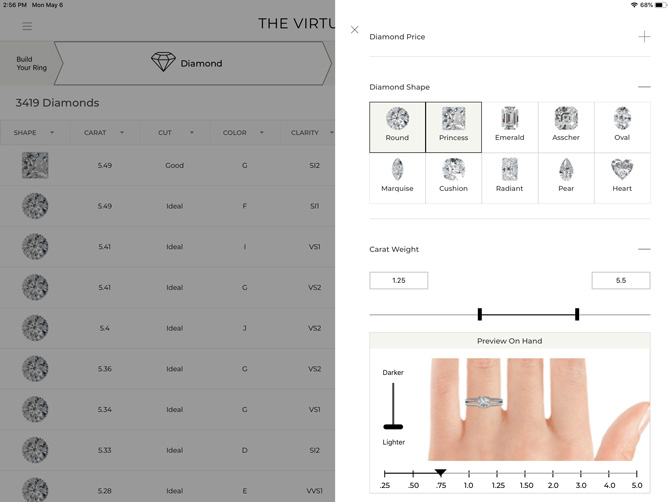
“We don’t have that in stock,” is a phrase Ritani doesn’t want any of its jewelry retailer partners to have to utter to their customers.
The New York City–based bridal and fine jewelry brand has pioneered a new technology that essentially extends the shelf space of a retail jewelry store—virtually.
Ritani’s new Virtual Shelf digital system sets up retailers with a branded tablet-based interface that gives them access to more than 250,000 diamonds and jewelry pieces, products they can share and sell directly from the app.
The application and sales tool surmounts some of modern jewelry retailers’ biggest challenges, namely the relatively limited scope of a store’s physical inventory—which can seem paltry to consumers who are accustomed to the endless aisles of Amazon and other online retailers—and costs related to managing transactions and technological innovations (more on that in a minute).
Here’s how Virtual Shelf works for retailers: Sales associates enter Ritani transactions with shoppers wielding an iPad preloaded with the Virtual Shelf app. If a customer wants an item that’s not in-store but is on the app (which is branded for each retailer), the retailer sets their margin and Ritani handles the entire back-end transaction for the jeweler, including fulfillment, credit card processing, fraud risk, and returns. The retailer immediately sees the transaction on their books, and the customer receives the item quickly and safely via insured shipping.

And there’s a social-selling aspect to the technology. Retailers can also list and sell their own inventory of certified diamonds and jewelry to other Ritani partner retailers (diamond owners set cost/list prices and margins) on Virtual Shelf.
The development of the technology was prompted by research Ritani conducted that found “nearly two-thirds of people who enter a jewelry store looking for a diamond leave without making a purchase, most often due to higher prices and a limited in-store selection,” according to company literature.
Josh Marion, vice president of Ritani and general manager of Virtual Shelf, tells JCK that the technology also sprung from the brand’s long, close working relationships with independent jewelers over the years. “We have been working with independent retailers since our founding 20 years ago [and] many of the core issues facing the industry back then…have been amplified in today’s on-demand, digital economy,” he says.
“While brick-and-mortar retailers have mastered their customer service and support, they’ve had difficulty competing with the lower pricing and product selection of online-only hubs. No longer do jewelers have to tie up funds to carry a large collection of jewelry on-premise. Virtual Shelf empowers these retailers to compete at scale with digital access to hundreds of thousands of diamonds, as well as jewelry, to help close the sale, along with a fully managed POS system.”
Ritani hopes the presence of the tablets (a device familiar to modern consumers) in stores will also help bridge the gap between the in-store and digital experiences.
The company will debut Virtual Shelf at the JCK Las Vegas show later this month—and interested retailers can learn more about the program and sign up for a one-on-one demonstration here.
Top: A screenshot from Ritani’s new Virtual Shelf app and selling tool (all images courtesy of Ritani)
Follow me on Instagram: @emilivesilind
Follow JCK on Instagram: @jckmagazine
- Subscribe to the JCK News Daily
- Subscribe to the JCK Special Report
- Follow JCK on Instagram: @jckmagazine
- Follow JCK on X: @jckmagazine
- Follow JCK on Facebook: @jckmagazine